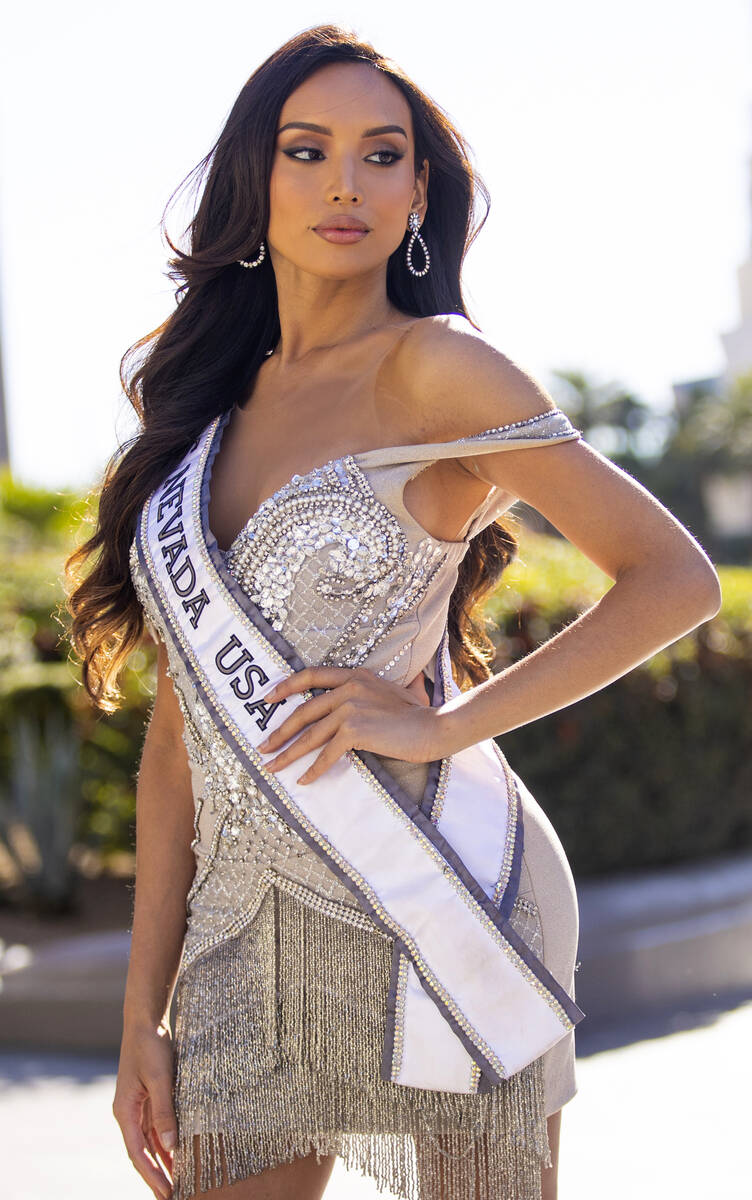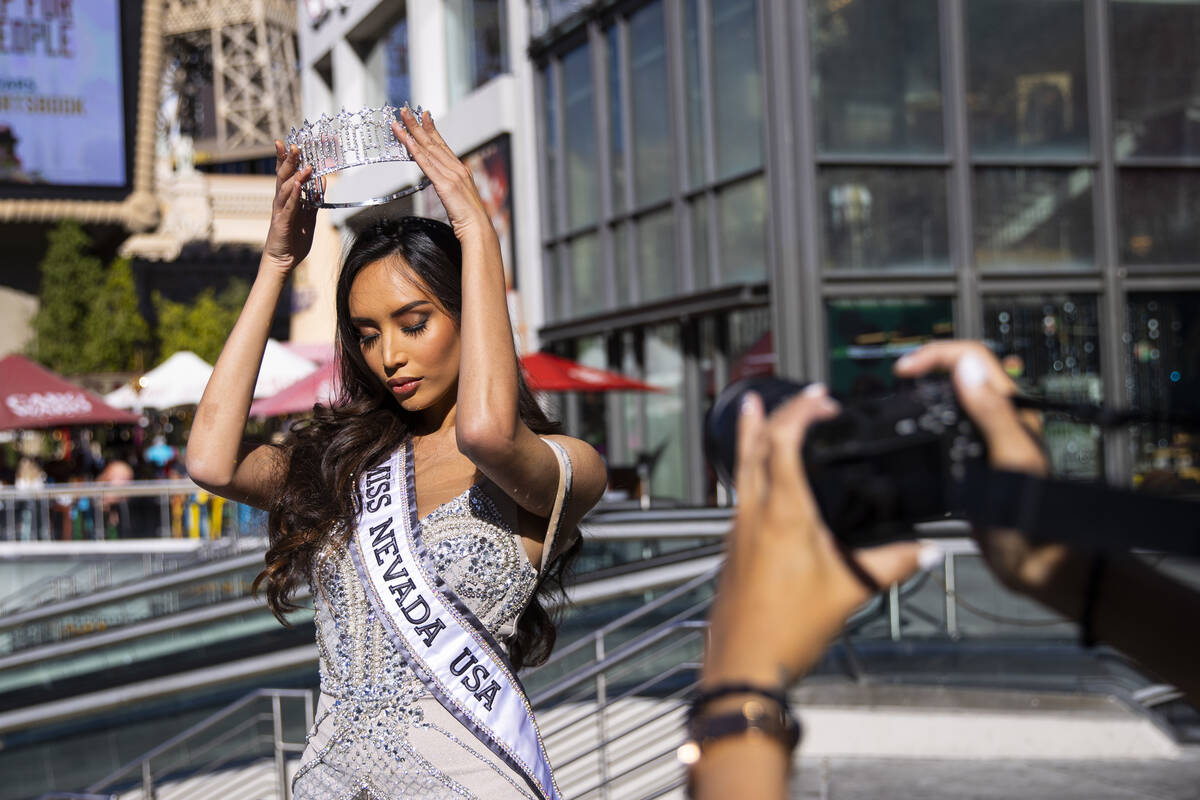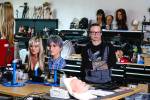Nevada’s Kataluna Enriquez looks to become 1st transgender Miss USA
It’s 11:30 a.m. on a Thursday in early November, and Miss Nevada is learning how to walk.
Four weeks from now, she’ll be in Tulsa, Oklahoma, making history as the first openly transgender contestant in the 69 years of the Miss USA pageant, which last made waves way back in 1987 when Bob Barker quit as host in protest over the use of fur coats as prizes.
Until then, though, it’s one foot in front of the other for Kataluna Enriquez at the west side Jordance Studios, whose mirrored walls simultaneously reflect both a woman in gold heels and white shorts pivoting her hips in semi-circles precise enough to have been drawn by a compass and a sense of imminent change.
“Slow first step. I need more hair flip,” instructs Marissa Castillo, director of the Miss Silver State pageant and former Miss Nevada 2016, who’s coaching Enriquez as she prepares for Miss USA. “You would think walking is an easy thing.”
Well, it was until now.
For the pageant, Enriquez must conduct her movements with the attention to detail of an NFL wideout running a slant route, where every step counts and timing is imperative.
And, it all needs to feel natural — even though it’s the opposite: studied, well-considered, highly-calibrated.
Think of it in acting terms: a leading lady has to internalize her dialog, inhabit it, so when she speaks, it doesn’t sound like she’s reciting lines from a script.
That’s what this is like.
And right now, it’s all about the arms.
“When we walk, you don’t realize, with most girls, only one arm will move,” Castillo says. “So you have to train them how to move both arms, to have a natural gait. Shoulders, posture, taking time to stand, how you stand — it’s everything. Someone’s power walk could win them the whole thing.”
Training for the Miss USA pageant is a full-time gig, a physical and mental endurance test with hours and hours spent preparing for the event in a daily routine akin to a sort of beauty-minded boot camp.
“The Miss USA pageant is like ‘America’s Next Top Model’ mixed with the UFC mixed with, like, a presidential debate, all in one,” explains Crystle Stewart, national director of the Miss USA and Miss Teen USA pageants who was also crowned Miss USA in 2008. “That’s what creates the pageant.”
Whether or not Kataluna Enriquez is crowned the next Miss USA on Monday night, her story is a remarkable one. Born in the Philippines before relocating to California when she was 10, Enriquez realized she was transgender at a young age — and was punished for it.
“I grew up very uncomfortable; I grew up being told, ‘No, you shouldn’t be doing this,’ when it felt natural for me,” Enriquez says. “For a long time I had to hide that and fight away that feeling of who I am.
“It really affected my struggle with my mental health, being constantly shamed, being put down, being attacked, being bullied to the point where I was just tired,” she continues. “I was tired of trying to live up to an expectation that didn’t necessarily fit me and didn’t serve me — and if anything, almost killed me.”
But then she discovered pageantry.
“I never thought that a trans person who was bullied, who had a background in physical and sexual abuse, who wanted to die at one point, would someday represent our state,” she says.
And yet, that day has come.
‘I started with my clothing’
She was a little kid trying to make herself smaller still.
How does one become invisible, exactly?
Kataluna Enriquez sought for a way, sought an escape from all those potentially prying eyes in the best of camouflages: anonymity.
“At a young age, when there were events at school — let’s say a school performance where your parents come to watch — I loved dancing and I loved performing, but I was always trying to ‘little’ myself; I was always trying to hide,” Enriquez recalls, “because I didn’t want people to make fun of me or out me. For a long time, I didn’t want the attention. I tried to hide myself.”
Enriquez’s childhood was a tumultuous one, as she recounts while perched on a beige couch in a suite at the Westgate, dressed casually in a long-sleeve gray top and white shorts, the words occasionally rendered a bit rubbery around the edges thanks to the Invisalign braces she’s wearing.
Enriquez, 28, works as a health care administrator and divides her time between Los Angeles and Las Vegas, where she’s lived since 2020.
A room high up in the same building where Elvis Presley once held court during one of the city’s most storied music residencies is a long way from Enriquez’s origins in a developing country whose GDP is less than one-tenth of California’s.
As a child, her parents left her and her siblings in their native Philippines to be raised by friends and relatives as they sought work abroad.
Eventually, the family reconvened in San Francisco, where Enriquez was thrust into a wholly new world.
She remembers hearing the sound of a train for the first time, how wide-open the yards were with their big lawns and her initial encounter with a certain tree-dwelling rodent.
“I had never seen a squirrel before,” she recalls with a chuckle. “I freaked out when I first saw one.”
She also remembers feeling different from everyone else.
“A lot of people, when you’re born, you know who you are and you’re comfortable with who you are,” she explains, at once a regal and down-to-earth presence, kind of like if you had an old college buddy who just happened to be a supermodel. “It was the complete opposite for me.”
“When I see gay people on TV and in media and everything else, I’m always, ‘Yes, I’m so happy for you,’” she elaborates, “but that’s not me, and my story was never reflected anywhere. I could never relate to anyone.”
And then, as a teenager, she happened to tune in to season four of “America’s Best Dance Crew,” which featured transgender dancer Leiomy Maldonado.
“I was cheering for her, and I was happy for her,” Enriquez says. “It gave me a glimpse, where, maybe the future could be like this. Maybe we could have a future where everyone is open-minded, where you can feel free to just express yourself without feeling or thinking, ‘When’s the next time you’ll be attacked.’ When I was young, I always wanted to be someone like that.”
And so that’s who she became.
In high school, mid-freshman year, she began transitioning — slowly.
“I started with my clothing,” Enriquez says, “then eventually I became more and more feminine and in touch with myself, re-learning who I am, re-learning what I’m comfortable with, re-learning how to use my voice and how to present myself to people, because I’d learned to just silence myself.”
After graduation, she then transitioned medically and started working as a model while also attending fashion school.
But the runway life wasn’t for her.
“I was tired of constantly having to limit what I eat or not having anything to say,” she says. “I wanted to be more than just a (clothes) hanger.”
And so she turned to pageantry, entering Los Angeles’ Queen Universe competition in 2015.
“It was terrifying, for sure,” she says of her first pageant. “I wanted to do the opposite things that I did when I was younger. I wanted to challenge myself, I wanted to grow, I wanted to taste life, I wanted to breathe, live, make mistakes, fail, hurt — everything. I wanted to feel the world.”
At Queen Universe, though, she failed to place.
Enriquez’s pageantry career nearly ended the very day it began.
“I thought that that wasn’t my field, that’s not my world and I shouldn’t do that,” she recalls. “But I learned that I was literally a few points away from actually making it to the top 10, and to me, that meant a lot.
“It meant that the judges saw something in me,” she continues. “And here I am now.”
Have scissors, will travel
You could say it all began with a 5-year-old’s chopped footwear.
“I was very young when I started sewing because my parents never got me the toys that I wanted, ” Enriquez explains. “I would lock myself up in the room, kick my sisters out, and play with their Barbie dolls. I would cut my socks and sew them together and make dresses out of them.”
Two decades later, she launched her own fashion line, KatalunaKouture, specializing in gowns and costumes.
For her pageants, Enriquez makes all her own dresses.
It’s an act born of both artistry and necessity: in the high-stakes, high-money world of national and international pageantry, gowns can cost tens of thousands of dollars.
“Most girls, they are fortunate enough to have parents that will grant them a $20,000 check,” Marissa Castillo says of the steep costs of pageantry-wear. “You have someone like Kat who didn’t have the means to have these crazy couture gowns — so she’s been making them.”
At Jordance Studios, Enriquez dons her latest creation: a shimmering, rainbow-colored gown that pops like a peacock’s plumage. and comes with a unique pattern stitched into it.
“This is kind of the shape of veins,” Enriquez explains of a portion of her dress, which she always designs to convey a message, she says. “(LGBTQ) pride isn’t just a month celebration, but something that is in my blood. It’s who I am. Pride is in you.”
The gown took weeks to make.
“When we’re done, it will be well over 10,000 stones, hand-placed by she and I,” notes Castillo, a fellow Filipina with dark-rimmed glasses and bright-eyed energy levels. “It’ll be over 100 hours put into the dress.”
Castillo has been working with Enriquez since May 2020, recruiting her after she saw her compete in a California pageant.
“I thought she was fabulous,” Castillo recalls. “I haven’t found contestants or girls with that type of passion and love for the stage.”
She saw Enriquez as talented, but in need of refinement — you couldn’t keep your eyes off her, and she couldn’t keep her eyes on you.
“When she used to walk into a room, she would look at the floor,” Castillo recalls. “There was not that sense of confidence and projection. As a queen, I called her out on it. I was like, ‘People want to see who you are. They want to speak to you. Keep your head up. Look at them. Embrace who they are.’ She has done beautifully.”
With Castillo at her side, Enriquez won the Miss Silver State pageant in March, becoming the first openly transgender woman to do so, then repeating the feat at the Miss Nevada competition three months later.
It’s been a whirlwind of media appearances, press junkets, red carpet walks and near-daily training ever since.
In addition to her work in the studio, Enriquez prepares for the interview portion of the competition with a one-to-two hour Zoom call every Wednesday evening with political insiders and other experts on current events to keep on top of the leading issues of the day.
She’ll have to answer the type of questions that can demand deep thought — potential lines of query: What do you look for in a friend? What are your thoughts on coronavirus vaccine mandates in the workplace? How do you define success? — without having much time to think at all.
“Pageantry is like a sport,” Crystle Stewart says. “Just like with football, basketball, whatever, you have to train for it. Not only are you training physically to be in the best shape you can be in, you train mentally as well. You have to be able to articulate your dreams, your hopes, your aspirations and answer everything with confidence, be able to answer on your toes as well. It’s a job interview — because being Miss USA is a job.”
Should Enriquez win the pageant, she’ll immediately be whisked off to Israel to compete for Miss Universe and then spend her year-long reign as Miss America doing speaking engagements, photo shoots, charity work and myriad public appearances.
Take a peek behind the velvet curtain of the pageantry circuit and there’s a real grind powering the glamour.
“They work so hard,” Castillo says of life as a contending beauty queen. “They eat, breathe and sleep pageantry. It’s a stereotype, ‘pretty girls in dresses.’ But it’s not always the fairy tale.”
Expressing herself
The smiles, her tiara, they all gleam beneath the lights in unison.
“1-2-3, gorgeous!” a photographer exclaims as Kataluna Enriquez in her Miss Nevada crown and sash poses for a picture with a teen girl rocking rainbow socks and a matching headdress whose spirits seem as high as the top-shelf hooch positioned above the bar across the room.
It’s Labor Day morning, and Enriquez is commanding the red carpet at the “Queen Among Queens Drag Brunch Extravaganza” at the upscale Echo & Rig steakhouse in Tivoli Village, where both the meats and the floors come finely marbled.
The event is a benefit for the Nevada Alliance for Diversity in Schools, a local nonprofit that “provides support for racially diverse, gender diverse, and neurodiverse students and their families,” according to its mission statement posted online.
As kids and their parents file into the lobby, Laura Hernandez, the organization’s executive director, takes in the scene.
Her daughter transitioned at 11 years old, and she subsequently co-founded the Alliance to help parents such as herself navigate life with a transgender family member.
For her, having someone like Enriquez become a public figure, living her life openly in the spotlight’s glare, is a significant development.
“When we started doing this, people didn’t even talk about these things,” Hernandez says. “For me as a parent, trying to support my daughter, I didn’t really have an example of how my daughter would grow up to be. That was a very scary thing.
“What future is there for them?” she wonders. “Who can she grow up to be? So, now, we can show families people like Kataluna who are very successfully living these beautiful and visible lives as an example for the kids about what kind of life they can have. It’s so incredibly important.”
That being said, Enriquez knows that not everyone wants to hear her story, acknowledges that the reaction to a transgender woman competing for the title of Miss USA has not been universally positive.
“It’s mixed, to be honest,” Enriquez says. “I think people are still trying to understand — some don’t want to understand, and I completely understand that.
Her understanding has its limits, though.
“It bothers me when they attack someone because of me, because someone said, ‘You are a beautiful woman,’ and then someone will say, ‘No, that’s a man,’” Enriquez says. “A person is just giving out a compliment, it has nothing to do with you, why do you have to attack someone?
“I think you should be able to express yourself, say what you want to say, regardless of what you believe in — you can call me whatever,” she continues. “I don’t care if you accept me; I don’t care if we agree — as long as you hear what I’m saying. There’s no point of having a seat at the table if you can’t speak.”
Enriquez is not the first transgender woman to compete in a pageant of Miss USA’s magnitude.
In 2012, transgender Miss Canada Jenna Talackova successfully fought for the right to compete in the Miss Universe pageant (Miss USA is a part of the Miss Universe system).
Six years later, Miss Spain Angela Ponce became the first trans woman to win the contest. Now, Enriquez is trying to duplicate that feat on these shores.
She wants to come out on top, for sure.
But in a way, victory will be hers regardless of Miss USA’s outcome, because win or lose, she’ll be seen, she’ll be heard.
Back at Jordance, Enriquez requests that Castillo play Jennifer Lopez’s “I’m Real” as they practice her gown walk.
“I’m real,” she says, repeating the song’s title, applying it to herself — the invisible kid, invisible no more.
“I’m not trying to be bold,” Enriquez explained two months earlier from her hotel room at the Westgate. “I’m not trying to be courageous.
“Everyone is always saying, ‘You’re courageous,’” she continues. “And I understand that. But to me, I just want to live.”
Contact Jason Bracelin at jbracelin@reviewjournal.com or 702-383-0476. Follow @jasonbracelin76 on Instagram.













































